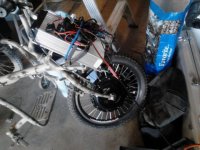wallypedal
100 mW
I have a 500W 36V front hub brushless motor from e-bike kit, 3 years old. Parked it when it started stuttering after 3 months use.
I want to know which hall sensors to get from where in order to replace the set. Think I've read every post on most of the ES and others, lots of info on how to change them. Not so much on where to buy, and which specific ones to get. Help? I'm new at working on these things, but pretty handy and systematic. Had the motor apart a couple times. On one of the bearings I can detect a little roughness or a bump, more than I'd like to know is there. Source for these bearings?
Thanks all!
Wallypedal
I want to know which hall sensors to get from where in order to replace the set. Think I've read every post on most of the ES and others, lots of info on how to change them. Not so much on where to buy, and which specific ones to get. Help? I'm new at working on these things, but pretty handy and systematic. Had the motor apart a couple times. On one of the bearings I can detect a little roughness or a bump, more than I'd like to know is there. Source for these bearings?
Thanks all!
Wallypedal



